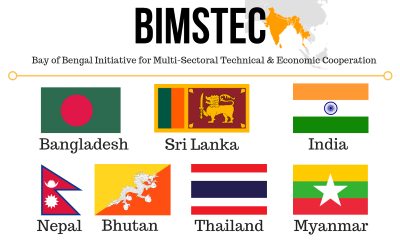Context:
India hosted the 2nd BIMSTEC (Bay of Bengal Initiative for Multi-Sectoral Technical and Economic Cooperation) Foreign Ministers’ Retreat in New Delhi earlier this month with a focus on providing an “informal platform to discuss ways and means of cooperating and accelerating action in security, connectivity, trade, and investment within the Bay of Bengal.” They are also expected to sign the BIMSTEC Agreement on Maritime Transport Cooperation to improve regional connectivity — a foundational aim of this grouping.
BIMSTEC’s Regional Cooperation
Strengthening Ties with Eastern Neighbours
BIMSTEC is dedicated to the Bay of Bengal region and includes five South Asian and two Southeast Asian countries, collaborating across seven diverse sectors. For India, BIMSTEC offers a crucial platform to engage multilaterally with its eastern neighbours, vital for its economic development, security, and foreign policy. India’s intent to strengthen relations with Bangladesh and Myanmar provides strategic advantages, including access to the sea for its landlocked northeastern region.
Potential for Regional Integration
BIMSTEC acts as a gateway for India to enhance its relations with Myanmar and Thailand to bolster India's presence in the Indo-Pacific, aligning with its vision of the region. Thailand positioned itself as a bridge between BIMSTEC and ASEAN (Association of Southeast Asian Nations), highlighting its significance. Minister for External Affairs S. Jaishankar emphasized that BIMSTEC embodies India's 'Neighbourhood First' outlook, 'Act East Policy,' and the SAGAR (Security And Growth for All in the Region) vision.
The organization’s focus on sectoral cooperation within the Bay of Bengal region aids in securing critical communication lines in the Indian Ocean Region (IOR) and enhancing trade opportunities. BIMSTEC aligns with India’s Security and Growth for All in the Region (SAGAR) vision, aiming to strengthen maritime cooperation within the IOR. BIMSTEC has the potential to address the shortcomings of SAARC (South Asian Association for Regional Cooperation) and emerge as a more effective platform for regional cooperation in South Asia.
Other Significances of BIMSTEC to India
● Strategic Bypass of Pakistan: BIMSTEC provides India with a strategic opportunity to bypass Pakistan in regional cooperation and trade, fostering closer ties with its eastern neighbours and improving its geopolitical positioning.
● Countering China: BIMSTEC offers a platform for India to counter China’s growing influence in the Bay of Bengal and the broader Indo-Pacific region. It enables India to push a constructive agenda that aligns with international norms and practices, providing a counter-narrative to China’s actions, especially in the South China Sea. India can leverage BIMSTEC to advocate for best practices in connectivity projects, distinguishing its approach from Chinese projects, which are often criticised for not adhering to international standards.
● Showcasing the Bay of Bengal: By promoting BIMSTEC, India can highlight the Bay of Bengal as a region characterised by openness and peaceful cooperation, contrasting with the more contentious aspects of China’s behaviour in the South China Sea. BIMSTEC is viewed as a potential cornerstone for a dynamic and economically vibrant Indo-Pacific region, contributing to regional stability and economic growth.
Two Parts of the Retreat
Segment One:
This session focused on evaluating the current state of regional cooperation within BIMSTEC, building on outcomes from the 1st Retreat. Member states proposed various initiatives, such as establishing Centers of Excellence in Agriculture, Disaster Management, and Maritime Transport. India committed to supporting cancer research, treatment, and issuing e-visas for patients from BIMSTEC states. Sri Lanka suggested including kidney disease in these initiatives. The discussion also highlighted the need for private sector involvement in trade, promoting young entrepreneurs, and addressing connectivity, cyber-security, and illegal trafficking issues.
Segment Two:
The second session addressed the expectations of each country for the upcoming summit. Sri Lanka emphasized mapping mineral resources and integrating production stages within BIMSTEC economies to diversify production structures. Bangladesh called for cooperation in the Blue Economy and proposed a ban on fishing during breeding seasons to protect marine resources. Bhutan advocated for tourism and cultural exchanges, while Nepal proposed leveraging synergies among member states to transform BIMSTEC into a results-oriented forum. Thailand highlighted the importance of non-traditional security cooperation, and Myanmar added the need to combat online scamming. These proposals will be presented to the heads of state before the September summit.
Bilateral Merits
The retreat had significant bilateral implications in addition to its multilateral achievements. Mr. Jaishankar held meetings with several counterparts and addressed Myanmar’s concerns about displaced persons, narcotics, and arms trafficking, and urged the return of unlawfully detained Indians. He also met with the Bangladesh Foreign Minister, who requested assistance in ensuring the smooth supply of daily essentials and a technical team for the Teesta project, moving towards resolving this long-standing issue. The retreat concluded with the Foreign Ministers meeting Prime Minister Narendra Modi.
Conclusion
It is evident that the Bay of Bengal has re-emerged as a critical focus in strategic planning and policy-making for both intra-regional and inter-regional integration. The competition for influence in the Indo-Pacific region plays a pivotal role in shaping this dynamic. This year marks a decade of India’s Act East and Neighbourhood First policies. The focus on BIMSTEC represents New Delhi’s ongoing efforts to foster collaborative growth for national and regional well-being. Minister Jaishankar’s call for future collaborations through new energies, resources, and a renewed commitment reflects India’s dedication to strengthening regional ties. The effectiveness of these proposals will be evaluated at the forthcoming summit, but the intent of BIMSTEC member states to advance a bold vision for the region was clearly demonstrated at the retreat.
|
Probable Questions for UPSC Mains 1. Discuss the strategic importance of BIMSTEC for India in the context of its ‘Neighbourhood First’ policy and ‘Act East Policy’. How does BIMSTEC help India in countering China's influence in the Indo-Pacific region? (10 Marks, 150 Words) 2. Analyze the outcomes of the 2nd BIMSTEC Foreign Ministers’ Retreat and its implications for regional integration in South Asia. What are the potential benefits and challenges of BIMSTEC’s focus on maritime cooperation, connectivity, and non-traditional security domains for India? (15 Marks, 250 Words) |
Source: Th







